Photographing Reflections
Photographing reflections can be a great way to add interest to your images. When you have a shot of both a subject and their reflection, it helps emphasize the subject. In some cases you might want to make the reflection itself a subject. And reflections can also work well for abstract photography.
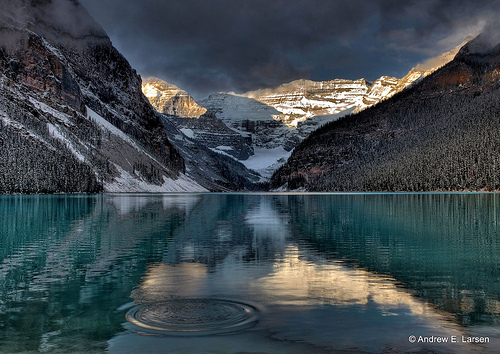
Dynamic Serenity by papalars on flickr (licensed CC-BY-ND)
When we think of reflections in photography, we normally think of reflections in water, probably in a lake, such as the above photo. But there are a large variety of different surfaces that give reflections. Puddles, mirrors, glass, polished metal, plastic, ceramic tiles, and varnished wood can all give good reflections.
When wet, other surfaces such as tarmac and sand can become reflective too. These surfaces likely won't reflect a perfect mirror image, but they do reflect enough light for a nice reflection photo. City streets at night after rain reflect the colors from shop windows and lit up signs.
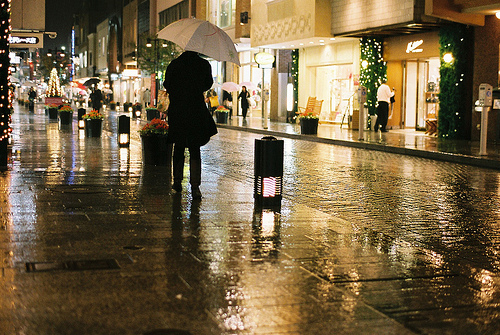
FM2_Motomachi_20111119_09 by Jun Takeuchi on flickr (licensed CC-BY)
Wet sand does not typically reflect as well as smoother surfaces, though it depends on how wet the sand is. It can work very well for reflecting the colors of sunrise and sunset.
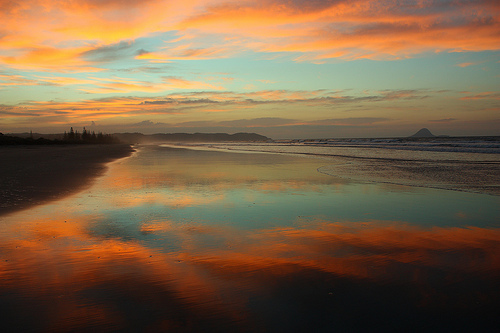
This was one beautiful Sunset tonight at Ohope Beach, New Zealand by Quiltsalad on flickr (licensed CC-BY)
Brightness of the reflection
When photographing a reflection in water you should notice that the reflection is darker than the actual scene being reflected. This is because water doesn't reflect 100% of the light that hits it, some of the light is absorbed by the water / travels through the water rather than being reflected.
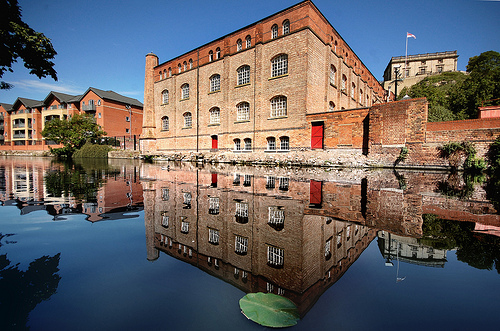
Victorian warehouse with Nottingham Castle in the background by blinkingidiot on flickr (licensed CC-BY-ND)
Similarly, other reflective surfaces reflect different amounts of the light that hits them. A wet tarmac street might absorb quite a bit of the light that hits it. A mirror, on the other hand, will reflect near enough 100% of the light that hits it.
If you are photographing a scene and reflection of that scene, and want them both to be the same brightness, there are a couple of things you can do. The first is simply to brighten the reflection or darken the scene in photo editing software after you've taken the photo.
The other option is to use a split or graduated neutral density filter. This is a filter that you place in front of your camera's lens. Half is dark, half is transparent. You place the dark half over the half of the photo that contains the scene, while the transparent half is over the reflection. This will reduce the amount of light over the scene (darkening it), so that both the scene and reflection of the scene are the same brightness.
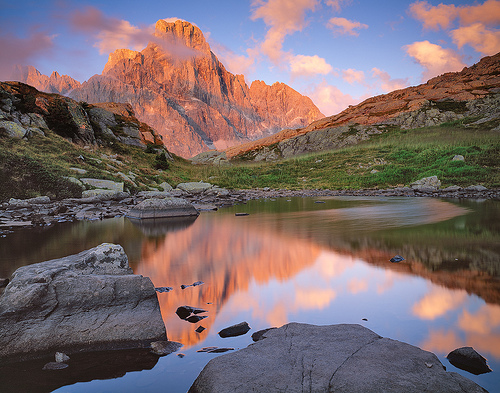
Cimon della Pala - August 2011 by rachel_thecat on flickr (licensed CC-BY-SA)
However, you should think about whether the photo will actually look better with both the reflection and scene at equal brightness before you do this. Sometimes the natural look, with the reflection being darker works best.
Symmetrical Composition
Many landscape photographs are composed so that the horizon is placed about one third down from the top of the image, or one third up from the bottom of the image. Although the rule of thirds is a good guideline for many photos, with reflections a symmetrical composition can work well.
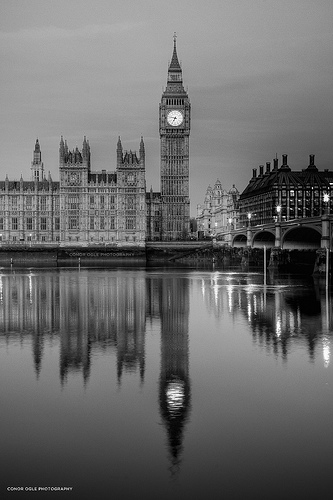
Dawn, meet Ben. Ben, this is dawn. by conorwithonen on flickr (licensed CC-BY)
Just like the 'rule' of thirds, this is only a guideline, and there will be plenty of situations where a different composition will work better though. Just consider a symmetrical composition when composing the photo, but go with whatever works best.
Interruptions in the reflection
Interruptions in a reflection can sometimes work for you, or sometimes against you. If you are photographing a product on a smooth glossy surface to get a nice reflection, then a scratch in the surface that breaks the reflection can be a problem. For this type of photo you want a nice clean reflection.
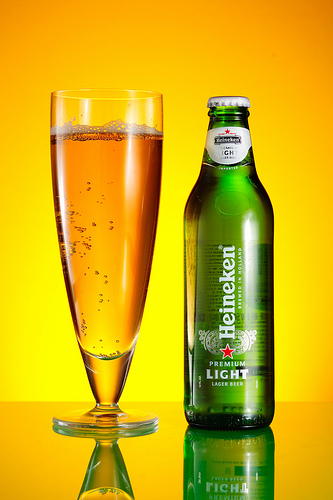
Touch the Hiney! (Heineken) by needoptic on flickr (licensed CC-BY-ND)
In other images a break in the reflection can help anchor the image, and make it clear that part of the image is the reflection, while the other part is the real subject. It can also provide a bit more interest to the image than a plain scene with a perfectly mirrored reflection.
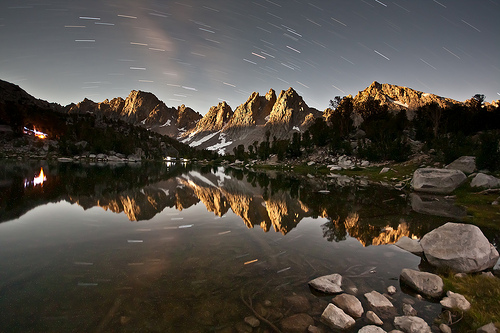
Kearsarge Pinnacles by Moonlight by Jeff Pang on flickr (licensed CC-BY)
Capturing mirror-like reflections in water
Mirror like reflections require very still water, so moving water such as a river or the sea is not suitable. Generally early in the morning or late in the afternoon (around sunrise or sunset) is best as it is not so windy and so the water will be calmer. As a bonus, this time of day often has beautiful warm light.
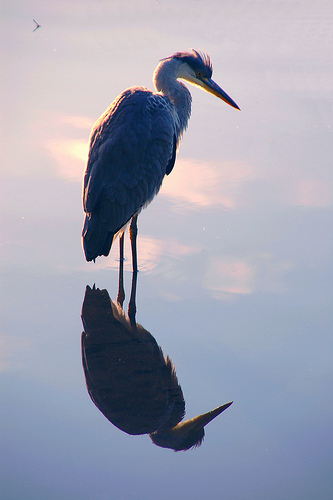
A perfect moment by blinkingidiot on flickr (licensed CC-BY-ND)
Painterly reflections in water
Water that is not completely still, but moving slightly can give a reflection that appears painterly. That is, the reflection is characterized by the qualities of color and tone rather than well defined lines, and a brush-stroke look to it.
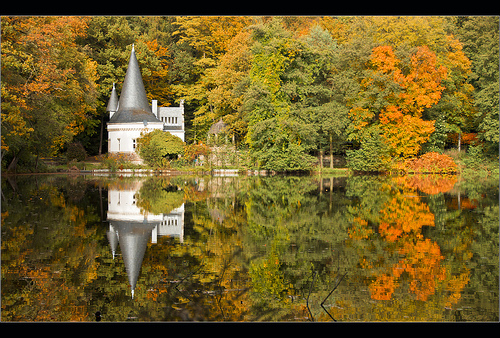
On Golden Pond by Bert Kaufmann on flickr (licensed CC-BY-SA)
This type of photograph can sometimes work well with only (or mostly) just the reflection in the image.
Reflections in moving water
In water that is moving more quickly, you will be unable to get a clear or painterly reflection. But the water will still reflect the colors. For sunset / sunrise images of the moving sea or a fast flowing river, this means the water will reflect the beautiful colors of the sky.
Focusing in on just the reflected colors of foliage or a building in a stream or river can provide for a nice abstract image. There is no longer an obvious subject, just the reflected colors.
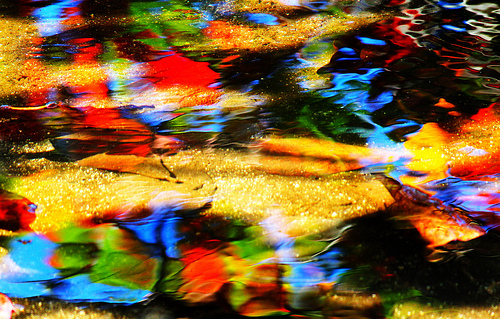
Water artistry: Colourful leaves in water by Peggy2012CREATIVELENZ on flickr (licensed CC-BY)
Reflections in windows
Windows can make for great reflections in towns and cities. A particular technique that can be used with windows is to capture both the view through the window and the reflection at the same time. Composing a photo this way to get both views working together can be tricky. But it can also result in a very nice shot.
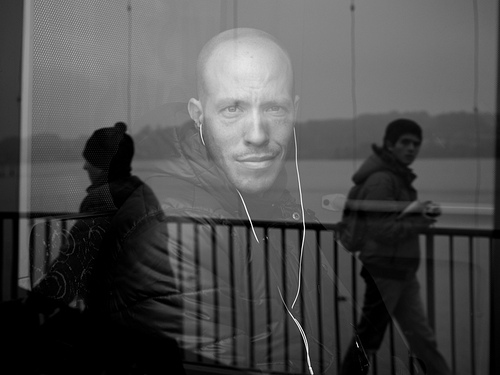
Why I love reflections... by Thomas Leuthard on flickr (licensed CC-BY)
The result is a bit like a double exposure, just that you have to capture both exposures at the same place and the same time.
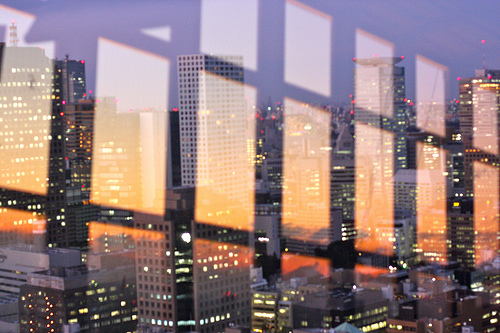
Framing the city by kevin dooley on flickr (licensed CC-BY)
Avoiding yourself in the reflection
Particularly when photographing a reflection in a mirror or window, it can be difficult to avoid capturing yourself in the photo. To do this, you just need to photograph the reflection from an angle rather than straight-on.
Of course, doing this does change the composition of the photo, and you may find the photo actually works better shot straight on with yourself in the image.
Depending on the image, in some cases you may be able to take two shots and then combine them. Take one photo where you're standing to the left, and another where you're standing to the right. Make sure that your reflection in the second image will not be overlapping with your reflection from the first image at all.
Take the two photos into your image editing software, and layer one image on top of the other. Then use a layer mask to paint out the area of the image with your reflection, revealing the area from the image below without your reflection in that area.
Alternatively, why not use your reflection as an important part of the image?
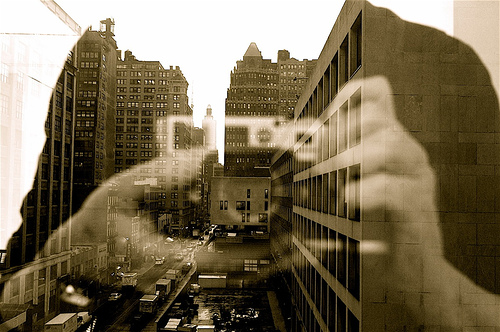
looking east . L1012496.JPG by Susan NYC on flickr (licensed CC-BY)
Avoiding glare
Glare from the sun can occasionally be a problem when trying to photograph reflections, especially in water. A polarizing filter is often used in general photography to reduce glare, but this will reduce the reflection as well.
To avoid glare, try to photograph scenes where the reflective area is in shadow, but the scene being reflected is well lit. This will create a strong, bright reflection, with no glare from the sun in the water.
When the sun is low in the sky you are also much less likely to have trouble with glare. The light from the sun will still light up vertical objects nicely, but will be spread out much more (lower intensity) over horizontal objects (such as the reflective surface of a lake).
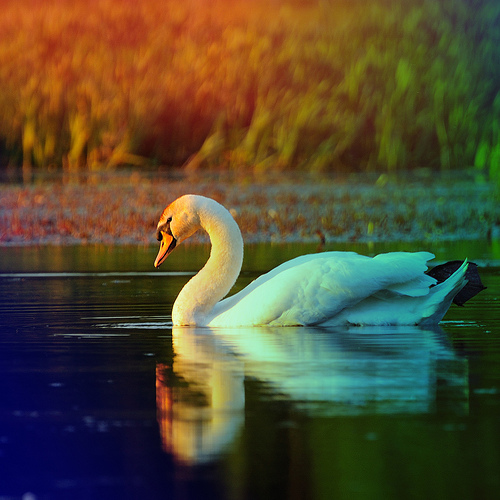
Lillhagensvan by Dirigentens on flickr (licensed CC-BY)
Note that glare often isn't a problem, even during the day time though. Areas of water that are in direct sunlight can still often provide nice reflections with no glare.
Capturing just the reflection
For some scenes, excluding the subject from the frame, while just including its reflection can work well. This technique seems to work particularly well with reflections captured in puddles.
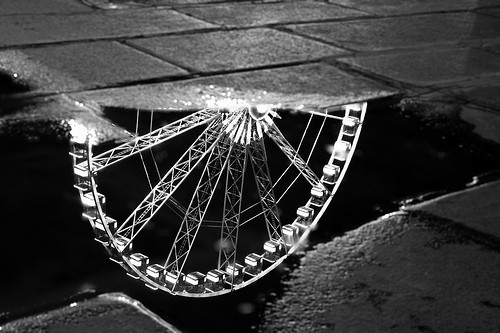
Reflection by Guy Lejeune on flickr (licensed CC-BY-ND)
As always with digital photography, don't be afraid to have fun and experiment when photographing reflections.




